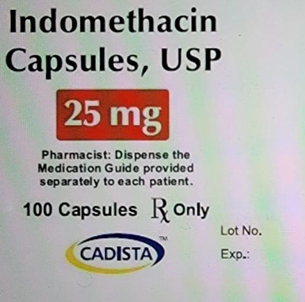What is the dosage on the drug label below?

100 mg
125 mg
25 mg
75 mg
The Correct Answer is C
A. 100 mg:. The label clearly states that each capsule contains 25 mg of Indomethacin. There is no indication that multiple capsules are taken at once unless prescribed, so 100 mg is incorrect for a single capsule dosage.
B. 125 mg: This is not the indicated dose per capsule.
C. 25 mg: The label clearly indicates that each capsule contains 25 mg of Indomethacin. This is the correct dosage per capsule. Indomethacin is often available in 25 mg increments for safe titration and individualized dosing based on patient need.
D. 75 mg: While 75 mg is a common dosage form for some extended-release Indomethacin preparations, this particular label shows 25 mg immediate-release capsules. There is no mention of 75 mg on the drug label in this case.
Nursing Test Bank
Naxlex Comprehensive Predictor Exams
Related Questions
Correct Answer is A
Explanation
A. Tablets: The drug label clearly states "Zoloft (sertraline hydrochloride) tablets," indicating that this formulation is in tablet form. It also mentions "30 Tablets" directly below the dosage strength, confirming the correct formulation.
B. Lozenge: Lozenges are designed to dissolve slowly in the mouth for local effect and are not typically used for systemic antidepressants like sertraline. This formulation is not indicated on the label.
C. Elixir: An elixir is a liquid form of medication containing alcohol, and although sertraline can be made in liquid form, this label specifically refers to tablets, not a liquid preparation.
D. Capsules: Capsules contain medication enclosed in a gelatin shell, often used for extended-release purposes. The label does not mention capsules and explicitly says "tablets," making this option incorrect.
Correct Answer is C
Explanation
A. "I should rinse my mouth with water and swallow it after using the inhaler.": Swallowing the rinse water may still allow corticosteroid particles to enter the systemic circulation through the gastrointestinal tract, increasing the risk of systemic effects and oral thrush.
B. "I will rinse my mouth only if I feel irritation after using the inhaler.": Rinsing should be done routinely after each use, regardless of the presence of irritation. Skipping this step can increase the risk of developing oral candidiasis (thrush) due to residual corticosteroid in the mouth.
C. "I will rinse my mouth with water and spit it out after using the inhaler.": Rinsing and spitting helps remove residual corticosteroid from the oropharynx, reducing the risk of local side effects like oral thrush and hoarseness.
D. "There is no need to rinse my mouth after using an inhaled corticosteroid.": This indicates a lack of understanding. Failure to rinse the mouth increases the risk of fungal infections and other local adverse effects due to prolonged exposure to the medication.
Whether you are a student looking to ace your exams or a practicing nurse seeking to enhance your expertise , our nursing education contents will empower you with the confidence and competence to make a difference in the lives of patients and become a respected leader in the healthcare field.
Visit Naxlex, invest in your future and unlock endless possibilities with our unparalleled nursing education contents today
Report Wrong Answer on the Current Question
Do you disagree with the answer? If yes, what is your expected answer? Explain.
Kindly be descriptive with the issue you are facing.
